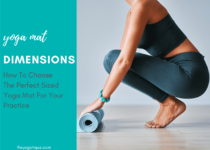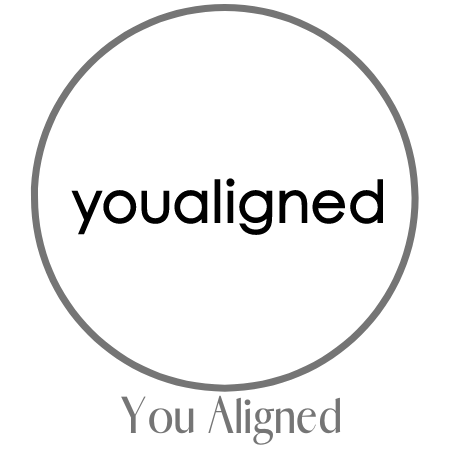A proper-sized yoga mat can make or break your practice. You need the optimal yoga mat dimensions for your body and your practice preference.
When I’m on my mat, I want to feel comfortable and like I have enough space to move around. Finding the right yoga mat for your yoga practice requires that you do a bit of research.
Fortunately for you, I’m giving you all the info you need to choose the perfect yoga mat size here. This one article is all it takes for you to become an expert on the dimensions of different yoga mats!
Article content:
(Click any link below to jump directly to section)
How to choose a yoga mat with proper dimensions
Why you need the right size yoga mat
An overview of the 3 standard sizes of yoga mats
Yoga mat thickness
Why different styles of yoga might require a different size yoga mat
5 reasons having a yoga mat is important
Takeaway on how to choose the right yoga mat dimensions
How to choose a yoga mat with proper dimensions
In general, your yoga mat should be wider and longer than you.
What matters the most when looking at yoga mat sizes is your height and weight, logically enough.
Yoga is for everyone, but not all yoga mats are – you really want to have a yoga mat size that supports your size as a human. Answer the following five questions when considering the dimensions of the yoga mat you'll need:
- How tall am I and how much do I weigh?
- Where will I be using this yoga mat?
- Where will I be taking my mat?
- What style of yoga do I plan to do?
- Do I need more than one yoga mat?
Tips for choosing the perfect yoga mat for your height
Here's the size yoga mat you need based on your height:
- Under 5'5″: Standard 68” mat
- Between 5.6′ and 6′: 72” mat
- Above 6 feet tall: 84-85” mat
Considerations for choosing the right size yoga mat
Choosing the right yoga mat size involves considering your available space and how you plan to use the mat, if you plan to use it for travel, and the style of yoga you plan to use it most for. Consider these questions to help you make the right choice when buying a mat:
- Space: how much space do you have for your mat?
- Location: where will you use the mat the most? At home, in a studio, or while traveling?
- Style of yoga: What style of yoga do you practice? Different styles of yoga require different thicknesses, for example. There's more about this below.
Why you need the right size mat for yoga
When it comes to your yoga mat, size matters! Your mat dimensions matter because you can stretch properly in any given pose on the right mat size. For example, you’re feet shouldn’t be hanging off of the back of the mat in Cobra pose, and you want to be able to take as wide of a stance as you wish in any Warrior pose.
You're not limited in your practice if you have a properly fitted yoga mat. If you’re not too tall, you can take advantage of the biggest perk of smaller yoga mats, which is their portability.
A yoga mat of proper thickness is key to comfort, support, and control. I get more into that later.
And if it’s cold, you will want as much warmth coming from your mat as possible. So that's where optimal thickness comes in.
How having the right size yoga mat enhances your practice
A properly sized yoga mat helps ground you and gives you more stability when needed.
By becoming aware of the sensations in your feet from touching the mat, you are more awakened and present.
A thinner mat is great for stability if you’re doing balancing poses, while thicker mats are great for therapeutic classes where you spend most of the class lying down.
An overview of the 3 standard yoga mat sizes
It’s good to know your options if you wish to find the best yoga mat size for you.
| Mat size | Dimensions | Description |
| Standard | 68-72” (173-183cm) X 24” (61cm) 0.12” (0.3cm) | Optimal for most styles of yoga. Offers cushioning & stability. |
| Large | 84” (213cm) X 36” (91cm) | Ideal for tall or larger bodies. Provides more space to move and stretch. Can be heavy. |
| Small | 60” (152cm) X 24” (61cm) | Compact and lightweight, easy to fold and carry, perfect for travel or limited practice spaces. |
Standard-size yoga mat dimensions
- Dimensions: 68-72” long (173-183cm) 24” wide (61cm).
Large-size yoga mat dimensions
A large-size yoga mat is usually a foot longer and/or wider than a standard yoga mat.
- Dimensions: Up to 84” long (213cm) and up to 36” wide (91cm)
For tall or big bodies, trying longer or extra-wide yoga mats might be a good idea. Such a mat will help you get the most out of your practice. This is certainly nice, especially if you just wish to sprawl out on your mat during a restorative session.
If carrying a large yoga mat is too cumbersome (they can definitely be heavy!), you can always ask to leave it at the gym or the studio you go to. When I taught at a studio, my students were allowed to leave their yoga mats, so they didn’t have to worry about the mat’s portability.
Small-size yoga mat dimensions
Small size yoga mats, also known as travel mats, are generally smaller and easier to fold, pack, and carry around.
- Dimensions: 60” long (152cm) by 24” wide (61cm)
⬇Great online yoga membership options you should look into⬇
Yoga mat thickness
The thickness of yoga mats can vary significantly. The thicker the mat, the better it protects you from injuries.
However, thicker yoga mats will make it more difficult to perform balanced poses. Here's the mat thickness I recommend for beginners and advanced:
- Beginners: Choose a thicker mat.
- Advanced: Choose a thinner mat.
Standard yoga mat thickness
- Standard mats: 0.125” (0.3175cm). It has the most intensity and the best grip.
- Extra padding mats: 0.4cm (0.157”) – 0.6cm (0.236”) great for sensitive knees
- Thick mats: 0.6cm – 1.2cm (0.23-0.47”)
Travel yoga mat thickness
- Travel mat: 0.03-0.07” (0.1-0.2cm) great for portability
Extra padding yoga mat thickness
- Thick yoga mats: 0.23” (0.6cm) – 3.9 – 4.7” (10 or 12cm) can feel wobble and unstable.
Why different styles of yoga might require a different size yoga mat
For more active styles that involve a lot of balancing, a thinner mat is the best option. A thicker mat, on the other hand, is recommended for therapeutic yoga classes, such as Yin yoga or Restorative.
The best-size yoga mat for Restorative yoga
For that extra plush feeling, thick yoga mats 0.5cm – 0.8cm (0.19-0.31”) are great. Since you don’t have to worry about balancing, you can opt for a softer, extra-wide yoga mat.
The best size yoga mat for Vinyasa yoga
If you practice a more vigorous yoga style, like Vinyasa, yoga mats that are thinner and denser will work best. The ideal thickness for Restorative yoga is 0.3cm – 0.4cm, because it provides better stability and balance. Also, make sure it’s a mat made of natural rubber, with a good grip and a non-slip surface.
5 reasons why having a yoga mat is important
A yoga mat is a space where our minds and bodies connect. In your yoga space, your yoga mat can serve as an anchor for all the beautiful feelings and states that your yoga practice can bring you to. Just stepping on it might be enough to activate a different mindset. Here are 5 benefits of practicing on a yoga mat versus the bare floor:
- It protects sensitive joints, especially in asanas where you place all your weight on your joints, such as plank.
- It helps you remain locked in a certain pose, such as an arm balance.
- Without it, you need to place more effort on your muscles and core, especially for transitions from and into a Downward Facing Dog.
- They provide great cushioning for your knees.
- Most yoga mats have a grippy and sticky surface to help you not slip up, even if you have sweaty feet.
Takeaway on how to choose the right yoga mat dimensions
As you can see, in yoga, size matters. Proper yoga mat dimensions are key for having a comfortable yoga class.
So don’t rush into buying the most hyped or expensive mat brand; rather, make an informed choice using the tips I provided to decide on the ideal yoga mat for you.
Some online yoga studios, online yoga teacher training programs, and brands that we write about may offer us a small commission should you decide to make a purchase or signup after reading our content. Thank you for enabling us to exist!









